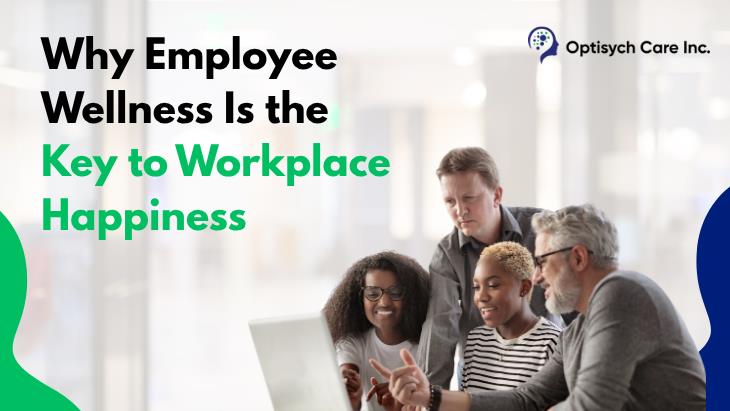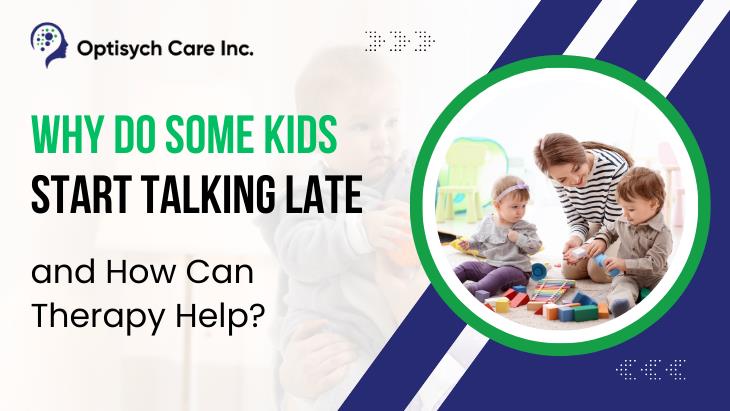The discussion on employee wellness in the contemporary dynamic business environment has evolved past the health check-ups and the fitness programs. It has now included all dimensions of mental, emotional, physical, and social well-being of an employee. Workplace happiness, on the other hand, is a situation in which employees are motivated and valued and have a feeling that they are doing their work.
Contemporary organizations have started realizing that the welfare of the employees is a direct factor that determines the productivity, creativity and job satisfaction. As a matter of fact, research has always proved that happier workers are more engaged and more productive as well as more loyal. This trend has seen the emergence of employee wellness programs meant to foster a holistic wellbeing and not just physical wellbeing.
Firms such as Optisych Care are leading the change they assist organizations to establish workplaces that support mental health, emotional resilience and general happiness. These programs are not mere perks but are a vital tool towards developing a high-performing and thriving working population.
Employee Wellness Demystified
In the simplest definition, employee wellness is a holistic measure of maintaining healthy employees, both physically and psychologically. It goes beyond such traditional corporate perks as medical insurance or annual health checks. Effective wellness programs are about the wholeness of the individual, including physical fitness, emotional stability, social connection, and mental health support.
The key distinction between traditional employee benefits and holistic wellness programs is the purpose. Traditional benefits are responsive—providing an answer to an issue that has happened. Conversely, the current wellness initiatives are preventive in nature by seeking to control problems by providing care, education and interaction on a regular basis.
The work-life balance is also taking the form of work-life harmony. Instead of isolating professional and personal life, organizations now acknowledge the fact that the two life aspects are related. An organized, healthy workforce will have vitality and creativity in the workplace, whereas a work environment filled with toxics or stress will leak into personal life, leading to burnouts as well as dissatisfaction.
The Correlation between Wellness and a Happy Workplace
It has a strong psychological correlation between a sense of support and happiness at work. Mental and emotional health programs on employee wellness promote trust, empathy, and a sense of belonging in the workplace.
Employees will be more motivated and loyal when they realize that their well-being is a concern. Treating employees with respect and care is done through wellness programs like mindfulness sessions, flexible schedules, or mental health counseling.
A study conducted by the American Psychological Association indicated that 89 percent of workers in firms that support well-being would refer their place of work. Equally, workers who attend wellness programs complain of increased engagement and general satisfaction with life.
Wellness in simple terms brings happiness, and happiness brings success. An employee who is happy is more productive, besides being more innovative and dedicated to the vision of the organization.
Essentials of an Effective Employee Wellness Program
An effective wellness program is a multi-dimensional one. The four pillars that any organization should focus on are as follows:
1. Mental Health Support
It is important to provide mental health professionals, counseling sessions, and stress management programs. Honest conversation on mental health minimizes stigma and makes employees get help at an early stage.
2. Physical Health
Promoting movement and activity by using fitness challenges, office ergonomic layouts, or gym memberships will make individuals physically fitter and will decrease fatigue at work. Employees who are healthy are more active and concentrated.
3. Emotional & Social Wellbeing
Team-building exercises, rewards and peer support networks increase employee morale and foster work relations. A feeling of trust is developed through emotional support and collaboration.
4. Work Flexibility
Flexible working hours, hybrid jobs, and mental health days will enable the employees to have greater control over their time. Such autonomy enhances job satisfaction, and burnout is avoided.
When these components are combined, they form a wellness culture that leads to increased happiness, loyalty, and organizational performance.
Positive Results of Diversifying Employee Wellness
Investing in employee wellness helps corporations to realize their gains in almost all spheres of their business.
High Productivity: Employees are healthier and happier; hence, they are more focused and efficient. They work smarter, not harder.
Less Absenteeism and Burnout: Wellness programs aid employees in dealing with stress, and therefore there are fewer sick days and turnover.
Improved Job Satisfaction and Loyalty: When employees feel taken care of, they have more chances of remaining long-term and promoting their workplace.
Better Company Culture: Wellness programs provide trust, collaboration and a sense of belonging.
Better Cooperation: Employees who are happier can communicate better, cooperate, and have a positive contribution to the work environment.
Finally, the investment in the wellness of employees is the investment in the sustainability of business. A productive and resilient workforce is a healthy workforce.
Actual Workplace Difference: Wellness to Happiness
The shift from wellness to happiness can very well be observed through companies that have adopted holistic well-being.
As an example, one IT company that introduced a weekly mental health check-in and stress management classes has seen a 40 percent reduction in employee turnover in 6 months. Flexible working hours and mindfulness were also implemented by another organization, which led to a significant increase in creativity and employee engagement.
The effects become multiplied when the leadership is actively involved in the initiatives. An inclusive and empathetic culture is established by a leader who appreciates wellness. The leaders can show that mental and emotional well-being are as critical as performance indicators by engaging in wellness programs and promoting open communication.
Using Effective Wellness Programs
The process of creating effective employee wellness programs must be planned and improved. Following are some of the steps that organizations may take in this order:
Evaluate Employee Requirement: Survey or focus group of employees to know if they actually need mental health care, flexibility, fitness programs, or work-life balance programs.
Design Custom Programs: Do not go with a one-size-fits-all program. Individualization guarantees inclusiveness and efficiency.
Implement and Communicate: Introduce the program in a clear way and advertise it by use of internal means of communication.
Promote Engagement: Consummate programs. Introduce games to enhance engagement.
Measure and Improve: Frequently assess results and change according to the employee feedback.
It is at this stage that Optisych Care comes in. The company assists organizations in designing tailored wellness solutions that are relative to their own culture, objectives and needs of their workforce. Having mental health support systems for training on emotional resilience, Optisych Care makes sure that the wellness programs bring about quantifiable outcomes.
Success of Happiness and Wellness Measurement
Wellness success is not merely a matter of attendance rates but a matter of influence. Monitoring of the appropriate Key Performance Indicators (KPIs) can also indicate the effectiveness of the working programs.
There are some measurable indicators, which include:
• Level of Employee Engagement Surveys: that measure levels of satisfaction and motivation.
• Turnover Rates: A decrease represents a better place of work.
• Absenteeism Data: Reduced sick days indicate better health, both mental and physical.
• Productivity Metrics: Increased output and creativity.
• Feedback Surveys: Firsthand information from employees regarding the value of the wellness program.
With the help of data-informed knowledge, organizations are able to optimize their strategies and form a process of constant improvement. Analytics will help companies maintain the relevance and effectiveness of their employee wellness programs by adding empathy to them.
Conclusion
Wellness among employees is not a luxury in the modern business world environment that is dynamic but a necessity. An effective wellness program fosters balance, resilience and
satisfaction, which eventually leads to organizational prosperity. Employees feel encouraged and more loyal to their jobs when they feel supported.
Happiness at work does not occur on perks but on a culture that appreciates human well-being. Investing in employee wellness programs, the companies establish the basis of innovation, loyalty, and future development.
When you are willing to establish a working environment where employees will genuinely flourish, associate with Optisych Care. We will collectively develop holistic wellness initiatives that will increase morale and engagement and turn your human resource into a community of happy, healthy, and high-performing people.






Leave a reply